Giochi dell'Oca e di percorso
(by Luigi Ciompi & Adrian Seville)
(by Luigi Ciompi & Adrian Seville)

|
Giochi dell'Oca e di percorso
(by Luigi Ciompi & Adrian Seville) |

|
 |

Torna alla ricerca giochi (back to game search) |
 |
| Nouveau (Le) Jeu de la Vie Humaine | ||
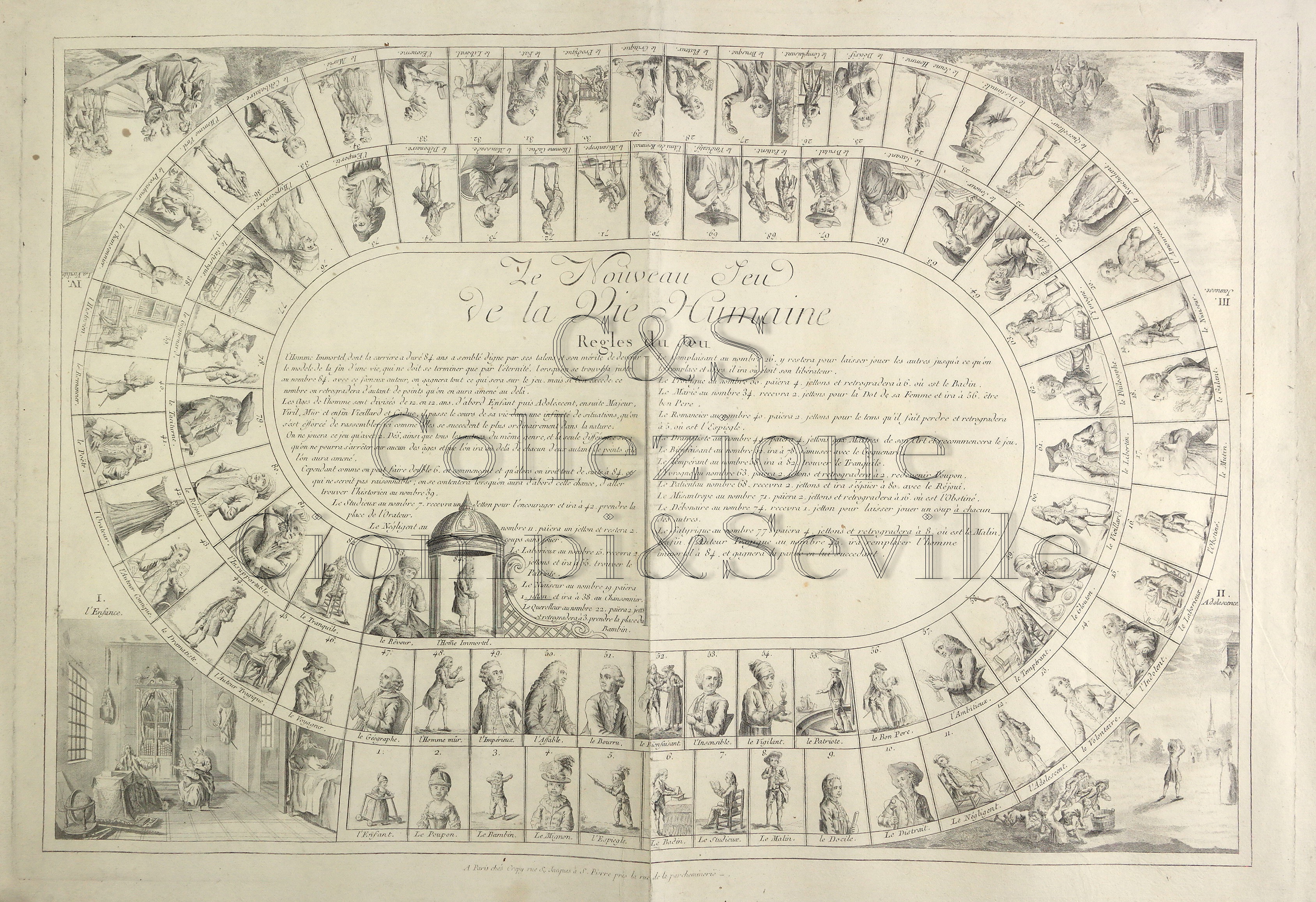 |
Versione stampabile
 |
Invia una segnalazione

|
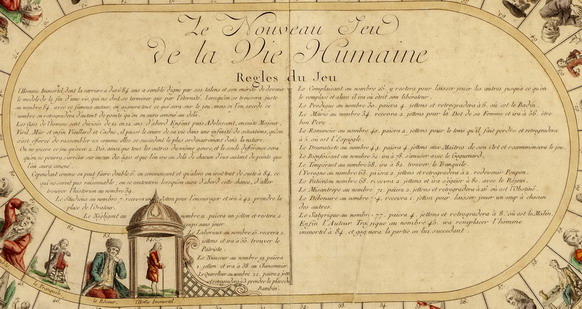  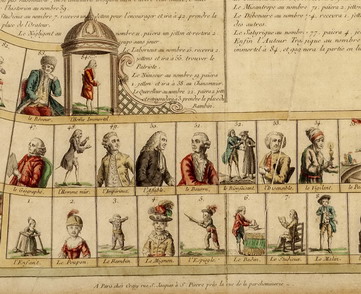 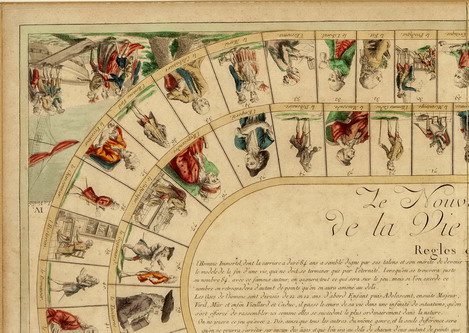  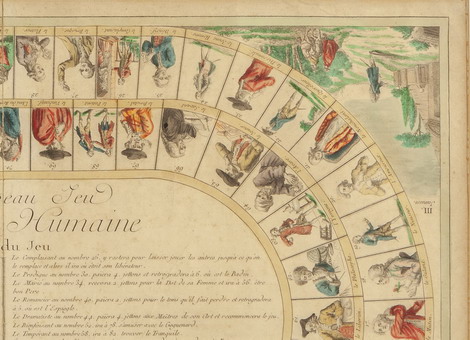 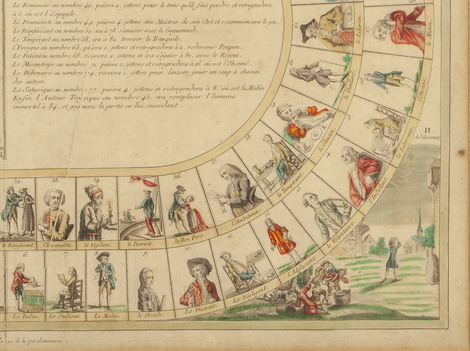  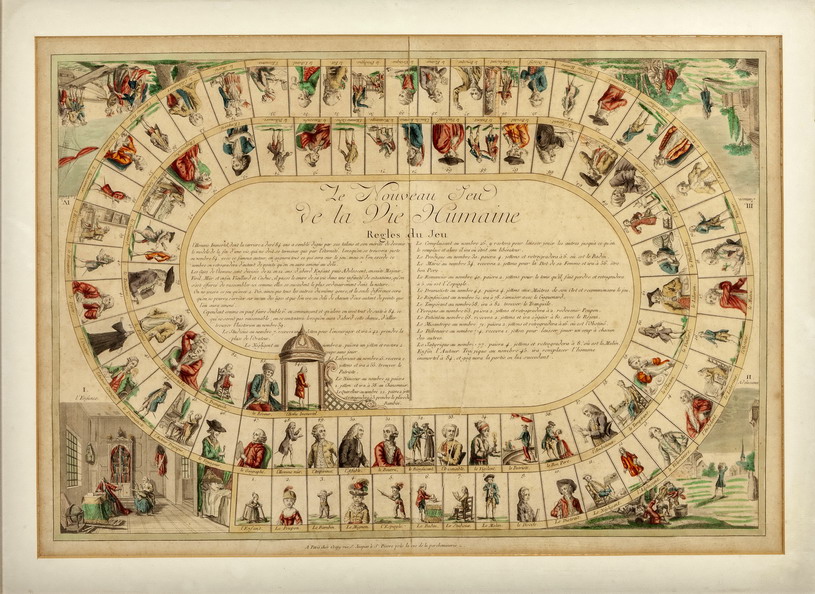 |
primo autore: | Anonimo |
| secondo autore: | Crepy | |
| anno: | 1775 | |
| luogo: |
Francia-Parigi |
|
| periodo: | XVIII secolo (4°/4) | |
| percorso: | Percorso di 84 caselle numerate | |
| materiale: | carta (paper) (papier) | |
| dimensioni: | 685X900 (465X687) | |
| stampa: | Acquaforte (taille-douce) (ecthing) | |
| luogo acquisto: | ||
| data acquisto: | ||
| dimensioni confezione: | ||
| numero caselle: | 84 | |
| categoria: | Vita umana, attualità, lavoro e tempo libero | |
| tipo di gioco: | Gioco di percorso | |
| editore: | A Paris Chez Crepy Rue S.t Jacques à S.t Pierre près de la rue de la Parcheminerie | |
| stampatore: | A Paris Chez Crepy Rue S.t Jacques à S.t Pierre près de la rue de la Parcheminerie | |
| proprietario: | Collezione A. Seville - Collezione Privata | |
| autore delle foto: | A. Seville - Antiquariato Boetto Genova | |
| numero di catalogo: | 2799 | |
| descrizione: |
Gioco di 84 caselle numerate, spirale, antiorario, centripeto. Si legge nelle regole: "L'homme immortel, dont la carrière a duré 84 ans, a semblé digne, par ses talents et son mérite, de devenir le modèle de la fin d'une vie qui ne doit se terminer que par l'éternité". Ognuna delle 84 caselle caratterizza lo stato d'animo del piccolo personaggio che debutta alla Cas.1 con l'infanzia e passa successivamente attraverso tutti i periodi dell'esistenza. L'autore ha adottato questo procedimento per poter caratterizzare nettamente gli stati d'animo del suo soggetto, le qualità, i difetti del suo carattere. L'ultima casella rappresenta evidentemente Voltaire che cammina appoggiato ad una canna. Al di sotto del personaggio una corona formata di stelle. Nell'angolo inferiore sinistro una scena della nascita del ragazzo che viene presentato al padre figurato come uno scienziato seduto ad un tavolo ripieno di carte con accanto un mappamondo. Nell'angolo inferiore destro viene presentata l'adoloscenza caratterizzata dai giochi di bambini. In alto a destra la gioventù simbolizzata da un grande personaggio con parrucca e spada e a sinistra la virilità si manifesta sotto forma di un signore che scende da un'imbarcazione per ricevere gli omaggi di una delegazione. REGOLE: al centro. "Règles du Jeu. L'homme immortel, dont la carrière a duré 84 ans, a semblé digne, par ses talents et son mérite, de devenir le modèle de la fin d'une vie qui ne doit se terminer que par l'étèrnité, lorsqu'on se trouvera juste au nombre 84 avec ce fameux auteur, on gagnera tout ce qui sera sur le jeu, mais si l'on excede ce nombre on retrogradera d'autant de points qu'on on aura amené au delà. Les Ages de l'homme sont divisés de 12. en 12. ans, d'abord Enfant puis Adolescent, ensuite Majeur, Viril, Mur et enfin Vieillard et Caduc, il passe le cours de sa vie dans une infinité de situations qu'on s'est éfforcé de rassembler ici comme elles se succedent le plus ordinairement dans la nature. On ne jouera ce jeu qu'avec 2 Dés, ainsi que tous les autres du meme genre, et le seule différence sera qu'on ne pourra s'arreter sur aucun des ages et que l'on ira au delà de chacun d'eux autant de points que l'on aura amené. Cependant comme on peut faire double 6 en commençant et qu'alors on iroit tout de suite à 84 ce qui ne seroit pas raisonnable; on se contentera lorsqu'on aura d'abord cette chance d'aller trouver l'historien au nombre 39. Le Studieux au nombre 7. recevra un Jetton pour l'encourager et ira à 42. prendre la place de l'Orateur. Le Négligent au nombre 11. paiera un jetton et restera 2 coups sans jouer. Le Laborieux au nombre 15. recevra 2 jettons et ira à 55. trouver le Patriote. Le Niaiseur au nombre 19. paiera 1 jetton et ira à 38. au Chansonnier. Le Querelleur au nombre 22. paiera 2 jettons et retrogradera à 3. prendre la place du Bambin. Le Complaisant au nombre 26. y restera pour laisser jouer les autres jusqu'à ce qu'on le remplace et alors il ira où étoit son libérateur. Le Prodigue au nombre 30. paiera 4 jettons et retrogradera à 6. où est le Badin. Le Marié au nombre 34. recevra 2 jettons pour la Dot de sa Femme et ira à 56. etre bon Père. Le Romancier au nombre 40. paiera 2 jettons pour le tems qu'il fait perdre et retrogradera à 5. où est l'Espiegle. Le Dramatiste au nombre 44. paiera 4 jettons aux Maitres de son Art et recommencera le jeu. Le Bienfaisant au nombre 52. ira à 78. s'amuser avec le Goguenard. Le Temperant au nombre 58. ira à 82. trouver le Tranquile. L'Yvrogne au nombre 63. paiera 2 jettons et retrogradera à 2. redevenir Poupon. Le Patient au nombre 68. recevra 2 jettons et ira s'égaier à 80. avec le Réjoui. Le Misantrope au nombre 71. paiera 2 jettons et retrogradera à 16. où est l'Obstiné. Le Débonaire au nombre 74. recevra 1 jetton pour laisser jouer un coup à chacun des autres. Le Satyrique au nombre 77. paiera 4 jettons et retrogradera à 8. où est le Malin. Enfin l'Auteur Tragique au nombre 45. ira remplacer l'homme immortel à 84. et gagnera la partie en lui succedant." CASELLE: con didascalia. Cas. 1): l'Enfance; Cas. 2): Le Poupon; Cas. 3): Le Bambin; Cas. 4): Le Mignon; Cas. 5): l'Espliegle; Cas. 6): Le Badin; Cas. 7): Le Studieux; Cas. 8): Le Malin; Cas. 9): Le Docile; Cas. 10): Le Distrait; Cas. 11): Le Negligent; Cas. 12): L'Adolescent; Cas. 13): Le Volontaire; Cas. 14): l'Indolent; Cas. 15): Le Laborieux; Cas. 16): l'Obstiné; Cas. 17): le Mutin; Cas. 18): le Galant; Cas. 19): le Niaiseur; Cas. 20): l'Amoureux; Cas. 21): le Nonchalant; Cas. 22): le Querelleur; Cas. 23): le Dissimulé; Cas. 24): le Jeune Homme; Cas. 25): le Decisif; Cas. 26): le Complaisant; Cas. 27): le Brusque; Cas. 28): le Flateur; Cas. 29): le Critique; Cas. 30): le Prodigue; Cas. 31): le Fat; Cas. 32): le Liberal; Cas. 33): l'Econome; Cas. 34): le Marié; Cas. 35): le Celibataire; Cas. 36): l'Homme Viril; Cas. 37): le Prosateur; Cas. 38): le Chansonnier; Cas. 39): l'Historien; Cas. 40): le Romancier; Cas. 41): le Poete; Cas. 42): l'Orateur; Cas. 43): l'Auteur Comique; Cas. 44): le Dramatiste; Cas. 45): l'Auteur Tragique; Cas. 46): le Voyageur; Cas. 47): le Geographe; Cas. 48): l'Homme Mur; Cas. 49): l'Imperieux; Cas. 50): l'Affable; Cas. 51): le Bourru; Cas. 52): le Bienfaisant; Cas. 53): l'Insensible; Cas. 54): le Vigilant; Cas. 55): le Patriote; Cas. 56): le Bon Père; Cas. 57): l'Ambitieux; Cas. 58): le Temperant; Cas. 59): le Glouton; Cas. 60): le Vieillard; Cas. 61): le Libertin; Cas. 62): le Philosophe; Cas. 63): l'Yvrogne; Cas. 64): l'Avare; Cas. 65): le Joueur; Cas. 66): le Savant; Cas. 67): le Brutal; Cas. 68): le Patient; Cas. 69): le Vindicatif; Cas. 70): l'Ami de hommes; Cas. 71): le Misantrope; Cas. 72): l'Homme Caduc; Cas. 73): le Maussade; Cas. 74): le Debonaire; Cas. 75): l'Emporté; Cas. 76): l'Hypocondre; Cas. 77): le Satyrique; Cas. 78): le Goguenard; Cas. 79): le Taciturne; Cas. 80): le Rejoui; Cas. 81): l'Insupportable; Cas. 82): le Tranquile; Cas. 83): le Reveur; Cas. 84): l'Homme Immortel. NOTA: vedere anche altro gioco nella Collezione Rothschild Arch. n°1185. REFERENZA 1 (D'Allemagne, pag. 206): "Le Nouveau Jeu de la Vie Humaine. Paris Crépy, (1775). Taille-douce. 47x69,5. Jeu à 84 vignettes: qualités et défauts du caractère. Dans les coins: l'Enfance, la Jeunesse, et la Virilité. Voir notice et Pl.11." REFERENZA 2 This game of 84 spaces is of considerable interest, not least because it pre-dates by fifteen years the better-known English version, the New Game of Human Life, published by John Wallis and Elizabeth Newbery in 1790 [see Giochi dell'Oca (Arch. n°144) for details and images]. Indeed, the English version is a very close copy of the French original, even to the extent of reproducing design and detailed layout, though all the images have been redrawn. This is indeed a game of human life: the track shows the various stages of life, beginning with the Infant, and then going through the early stages of childhood. However, the track continues with the various qualities and kinds of temperament: the malignant boy, the studious boy etc., as listed in the catalogue. The game is a goose variant, but the favourable spaces are spaced by twelve to give the seven ages of man: L’Adolescent (12), Le Jeune Homme (24), L’Homme Viril (36), L’Homme Mur (48), Le Veillard (60), L’Homme Caduc (72) and L’Homme Immortel. The equivalents on these spaces in the English version are: the Youth, the Young Man, the Prime of Life, the Sedate Man, the Old Man, Decrepitude, and the Immortal Man. There is a special rule for the initial throw of double six (corresponding to the Goose rule for the initial throw of nine), pointing out that to double the throw forward to the end would ‘not be reasonable’ and that the thrower must be content to move only to the Historian at space 39. The hazards do not correspond numerically to those in Goose and, though the penalties are similar in nature, they have their own rationale. Among these, we may note: The Studious Youth at space 7 goes on to become the Orator at space 42; the Complacent Man at space 26 must stay until another takes his place; the Prodigal at space 30 must pay and go back to space 6, the Careless Youth; the Husband at space 34 receives 2 as marriage portion and goes on to space 56, the Good Father; the Writer of Romances at space 40 must pay for time wasted and go back to space 5, the Mischievous Boy; the ‘death’ penalty is reserved for the Dramatist at space 44, who must pay ‘to the Masters of his Art’ and start the game again. The final rule states that the Tragic Author at space 45 goes on to become the Immortal Man, and wins the game outright. D’Allemagne (1950: 74) considers that the Immortal Man of the French version is Voltaire, shown leaning on a stick in characteristic pose: he died at the age of 84, corresponding to the length of the track. [But see Laurence 2002 for another view] When the game was copied for Wallis and Newbery in 1790 [see Hannas (1972: 32 and 115)], several of the characters were changed to represent well-known Englishmen such as Alexander Pope (the Poet, space 41), Captain Cook (shown with a globe as the Geographer at space 47), Pitt (the Patriot, space 55), the Prince Regent (at space 57, in a crude caricature to represent the Ambitious Man), and Isaac Newton (84), since it was thought that an atheist was unsuitable for a British audience: Newton, like Voltaire, died at the age of 84. (Plock, Phillippa - Seville Adrian) REFERENZA 3 "The New Game of Human Life (Le Nouveau Jeu de La Vie Humaine)", c. 1779; published by Jean Baptiste Crépy (active c. 1753-1790, d. 1796), Paris, etching and engraving. Waddesdon Manor, The Rothschild Collection (Rothschild Family Trust).This game exemplifies new ideas about the virtuous life. The figure depicted in the final space is the great writer and thinker Voltaire (1694-1778). In the centre of the sheet, the rules of the game explain that status based on talent and merit over a career of 84 years earned him immortality. The four corners show the Ages of Man. The sequential spaces contain further images of the Ages of Man as well as different character-types and professions, such as the poet and the philosopher. Unlike the New Noisy Game of the Street Cries, this game emphasises the value of work associated with thought and education, such as the orator and the historian. In depicting the stages of development from childhood to adolescence, square 6, le Badin, shows a boy building a house of cards, after the paintings of the same title by Chardin. (Jacobs Rachel) Exhibitions - "Playing, Learning, Flirting: Printed Board Games from 18th-Century France". Catalogue exhibition of French eighteenth-century Board Games, 28 March – 28 October 2012, Waddesdon Manor, The Rothschild Collection (Rothschild Family Trust). Rachel Jacobs, Curator. |
|
| bibliografia: |
1) CREPY, Jean Baptiste: “Estampes pour servir à la Récréation de l'Esprit sous la forme du Jeu Royal de l'Oye Renouvelé des Grecs. Pour l'Education des Jeunes Gens de l'un & de l'autre Sexe”. Lesquelles se trouvent à Paris chez Crepy, Rue S.t Jacques à S.t Pierre près la Rue de de la Parcheminerie. A. P. D. R. Paris, 1780ca (contiene 26 giochi rilegati). 2) ALLEMAGNE, Henry-René D’: "Le noble jeu de l’oie en France, de 1640 à 1950", Ed. Grund, Parigi 1950 (Tav. 11). 3) WHITEHAUSE, F.R.B.:"Table Games of Georgian and Victorian Days", London, Peter Garnett, 1951. 4) GOODFELLOW, Caroline: "A Collector's Guide to Games and Puzzles". Secaucus, New Jersey, Chartwell Books-London, Quintet Publishing Limited 1991. 5) GOODFELLOW, Caroline:"The Development of the English Board Game, 1770-1850", in Board Games Studies 1, 1998. 6) GOODFELLOW, Caroline:"Jeux de société. Le guide du collectionneur des jeux de société depuis le XVIIIe siècle jusqu’à nos jours", (Edizione francese) Carrousel MS, 2001. 7) SEVILLE Adrian, SPEAR John:"The Game of the Goose in England, a tradition lost". In "The ephemerist" n° 151, Winter 2010, London. 8) PLOCK, Phillippa - SEVILLE, Adrian: "The Rothschild Collection of printed board games at Waddesdon Manor". Proceedings of the XIIIth Board Game Studies Colloquium, Paris, 14-17 April 2010. 9) PLOCK, Phillippa - SEVILLE, Adrian: "La Collection Rothschild de Jeux de l’Oie et de parcours à Waddesdon Manor". In "Le Vieux Papier", Fascicolo 404, Aprile 2012, pag. 433- 444, 2012. 10) GOODFELLOW, Caroline:"How We Played: Games From Childhood Past", History Press, 2012. 11) ROVEE, Christopher: “The New Game of Human Life, 1790.”. In: BRANCH (Britain, Representation and Nineteenth-Century History.) Ed. Dino Franco Felluga. Extension of Romanticism and Victorianism on the Net. Web, 2014. |
|
| D'ALLEMAGNE, Henry-Renè: "Le noble jeu de l’oie en France de 1640 à 1950" (pag. 74) | ||
Vai alla ricerca giochi Vai all'elenco autori